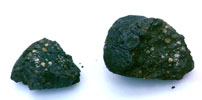
| MetSoc Home Publications Contacts |
 |
||
|
||
| Elephant Moraine 96286 | |||||||||||||||||||||||||
|---|---|---|---|---|---|---|---|---|---|---|---|---|---|---|---|---|---|---|---|---|---|---|---|---|---|
| Basic information | Name: Elephant Moraine 96286 This is an OFFICIAL meteorite name. Abbreviation: EET 96286 Observed fall: No Year found: 1996 Country: Antarctica [Collected by US Antarctic Search for Meteorites program (ANSMET)] Mass:  12.9 g 12.9 g | ||||||||||||||||||||||||
| Classification history: |
This is 1 of 185 approved meteorites classified as CR2. [show all] Search for other: Carbonaceous chondrites, Carbonaceous chondrites (type 2), and CR chondrites | ||||||||||||||||||||||||
| Comments: | Revised 12 Feb 2010: reclassified in AMN 33(1) | ||||||||||||||||||||||||
Writeup |
Writeup from AMN 21(2):

Macroscopic Description: Carol Schwarz
Thin Section (,2) Description: Tim McCoy Writeup from AMN 33(1):
EET
96286 original classification in AMN
21, no. 2 as a CV3 chondrite, but several studies have brought information to
light that is inconsistent with that classification. Raman data, as well as isotopic data for C,
H, and O indicate this meteorite is not a CV3, but a CR2 chondrite [1,
2].
[1] Busemann, H. et al., (2007) Characterization of insoluble organic matter in primitive meteorites by microRaman spectroscopy. Meteoritics & Planetary Science 42, 1387–1416. [2] Makide, K. et al., (2009) Oxygen- and magnesium-isotope compositions of calcium–aluminum-rich inclusions from CR2 carbonaceous chondrites. Geochimica et Cosmochimica Acta 73, 5018–5050. | ||||||||||||||||||||||||
| Data from: MB83 Table A1 Line 214: |
|
||||||||||||||||||||||||
| Catalogs: |
| ||||||||||||||||||||||||
| References: | Published in Antarctic Meteorite Newsletter 21(2) (1998), JSC, Houston Published in Antarctic Meteorite Newsletter 33(1) (2010), JSC, Houston Published in Meteoritical Bulletin, no. 83, MAPS 34, A169-A186 (1999)
| ||||||||||||||||||||||||
| Photos: |
| ||||||||||||||||||||||||
| Geography: |
Statistics: This is 1 of 44543 approved meteorites from Antarctica (plus 3802 unapproved names) | ||||||||||||||||||||||||
| Proximity search: | |||||||||||||||||||||||||
| Also see: |
This lists the most popular meteorites among people who looked up this meteorite.
| ||||||||||||||||||||||||
| Revision history: |
This lists important revisions made to data for this record.
| ||||||||||||||||||||||||